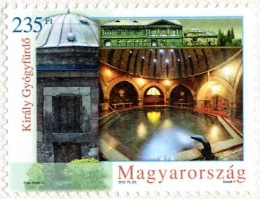
1. MAGYAR - EGÉSZSÉGTURIZMUS - GYÓGYFÜRDŐK II. - Bélyeg rendelési kód: 2012 év bélyegei kompletten
2. ENGLISH - HEALTH TOURISM - SPAS II. - Order code of the stamp: 2012 Year stamps complete
1. MAGYAR - EGÉSZSÉGTURIZMUS - GYÓGYFÜRDŐK II.
Két címlettel bővül az Egészségturizmus - Gyógyfürdők forgalmi bélyegsor
A Magyar Posta két új címlettel bővíti Egészségturizmus - Gyógyfürdők forgalmi bélyegsorozatát. A filatéliai újdonságok a budapesti Király és Rudas Gyógyfürdő jellegzetes külső és belső részleteit ábrázolják. Az alkalmi borítékok és bélyegzők grafikáját a fürdőkhöz kapcsolódó kompozíció díszíti. A kiadványok Hajdú József művészfotóinak felhasználásával, Svindt Ferenc grafikusművész tervei szerint a Pénzjegynyomdában készültek.
A Király gyógyfürdő (Budapest II. ker., Fő u. 84.) építését 1565-ben Arszlán budai pasa kezdte meg és utóda, Szokoli Musztafa fejezte be. Nem volt és ma sincs közvetlen melegvíz-bázisa, mivel a törökök a forrásoktól távol, a várfalon belül építették a fürdőt, hogy egy esetleges ostrom idejére is biztosítva legyen a fürdés lehetősége. Vizét akkor is és ma is a jelenlegi Lukács Fürdő környékéről biztosították. Buda visszafoglalását követően 1796-ban, a fürdő a König család birtokába került, ők építették át mai formájára, ötvözve a régit az újjal, megőrizve műemlék-voltát. A fürdő magyarosított nevét is a családról kapta. A II. világháborúban a fürdő megrongálódott, teljes felújítására 1950-ben került sor. 4 medencével várja a gyógyulni vágyó közönséget. Vize nátriumot is tartalmazó kálcium-magnézium-hidrogénkarbonátos és szulfátos-kloridos hévíz, melynek fluoridion-tartalma is jelentős. Alkalmazása javasolt ízületek degeneratív betegségei, idült és félheveny ízületi gyulladások, porckorongsérv, gerincdeformáció, idegzsábák, a csontrendszer mészhiánya és sérülés utáni állapotok esetén.
A Rudas gyógyfürdő (Budapest I. ker., Döbrentei tér 9.) 1566-72 közötti felépítése Szokoli Musztafa budai pasa nevéhez köthető. Ún. ilidzsa típusú fürdő (termálfürdő) volt, amely a források vizének hasznosításával épült. Épületének magja a török fürdő nyolcszögletű medencéje és nyolc oszlopos medencetere. Az oszlopokra támaszkodik a felülvilágítókkal áttört félgömb kupola. A kupolatér négyzet alaprajzú tér, sarkain negyed gömb kupolákkal, alattuk sztalaktit boltozattal, amely a török építészetre jellemző lépcsőzetes kialakítással készült. Török kori neve a „Zöld oszlopos fürdő”, melyet a régészek szerint a ma már nem álló zöld oszlopról kaphatott. Jelenlegi nevére több vélemény is felvetődött. A lehetséges változatok egyike, hogy a kompkikötő rúdjáról kapta a nevét, mások szerint a környéken élő rácok által használt Rudna ilidzse (ásványos fürdő) névből alakult ki a Rudas elnevezés. A 2004-ben megkezdett átépítési munkálatok nagymértékben érintették a fürdőt. Ma már hat gőzmedencével és egy uszodával várja a gyógyulni és felfrissülni vágyókat. Vize nátriumot is tartalmazó kalcium-magnézium-hidrogénkarbonátos és szulfátos, radioaktív hévíz, melynek fluoridion-tartalma is jelentős. Javasolt ízületek degeneratív betegségei, idült és félheveny ízületi gyulladások, porckorongsérv, idegzsábák és a csontrendszer mészhiányos állapotainak kezelésére. (Forrás: budapestgyogyfurdoi.hu )
Forrás: Posta
2. ENGLISH - HEALTH TOURISM - SPAS II.
Magyar Posta is expanding its regular stamp series Health Tourism – Spas with two new denominations. The philatelic novelties depict characteristic interior and exterior details of Budapest’s Király and Rudas Baths. The graphics of the first day covers and the postmarks are decorated with compositions related to the baths. The stamps were made by printing company Pénzjegynyomda using artistic photographs by József Hajdú and designs by the graphic artist Ferenc Svindt.
The construction of the Király Baths (Budapest, District II, Fő u. 84) was started by Arslan, the Pasha of Buda, in 1565, and completed by his successor Sokoli Mustafa. It did not and does not have its own direct supply of thermal water as the Turks built the baths some distance from the springs within the city walls to ensure bathing could continue in the event of a siege. The water was fed from the neighbourhood of the Lukács Baths, as it still is today. A century after the end of Turkish rule, the baths came into the ownership of the König family in 1796, who rebuilt it to its present form, combining the old with the new while preserving its original character. The name of the König family in Hungarian (király), which means king, was adopted by the baths. The baths, which were damaged in the Second World War, were fully restored in 1950. There are 4 pools for public use. The thermal water contains sodium, calcium, magnesium, hydrocarbonate and sulphate chloride, and also has high fluoride ion content. It is recommended for the treatment of degenerative joint diseases, chronic and subacute arthritis, discus hernia, spinal deformity, neuralgia, skeletal calcium deficiency and postaccident rehabilitation.
The construction of the Rudas Baths (Budapest, District I, Döbrentei tér 9) between 1566 and 1572 is associated with the name of the pasha of Buda Sokoli Mustafa. It was an Ilige style bath, which used thermal water. The heart of the baths is the Turkish eight-columned hall with an octagonal pool. The columns support a semispherical dome, which lets light into the building. The dome hall has a square floor plan with semidomes in each corner and stalactite vaults beneath them, which are tiered and typical of Turkish architecture. In the Turkish era it was known as the green-columned baths, which archaeologists believe was named after a green column which is no longer extant. There are several explanations of its current name. One is that it was named after the pole (rúd in Hungarian) to which the ferry on the Danube moored, while others think that it is derived from the name the Serbs living in the neighbourhood used for the Baths, Rudna Ilige, meaning mineral baths. The building was greatly affected by the reconstruction works started in 2004. Today there are six steam pools and a swimming pool for visitors seeking relaxation and recovery. The radioactive thermal water contains sodium, calcium, magnesium, hydrocarbonate and sulphate, and also has high fluoride ion content. It is recommended for the treatment of degenerative joint diseases, chronic and subacute arthritis, discus hernia, neuralgia and skeletal calcium deficiency. (Source: budapestgyogyfurdoi.hu)










